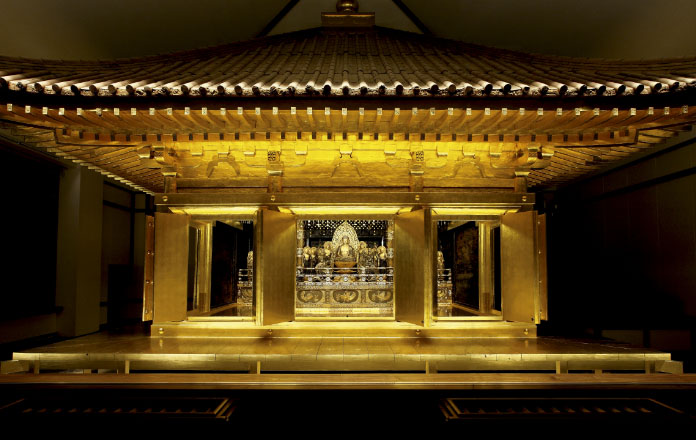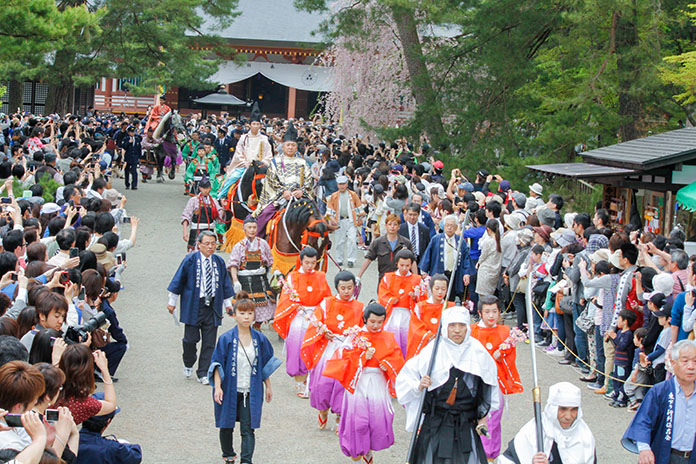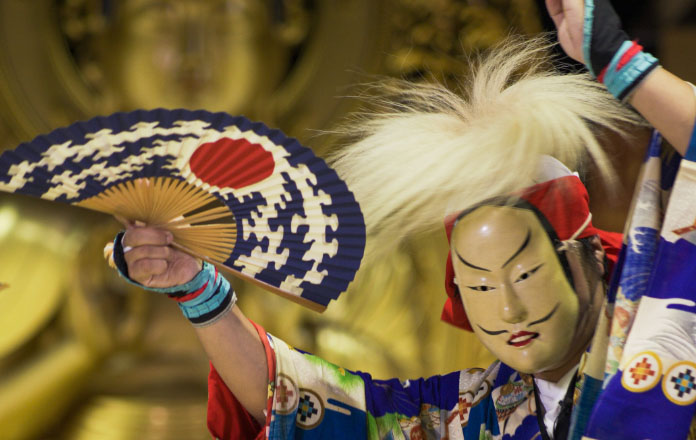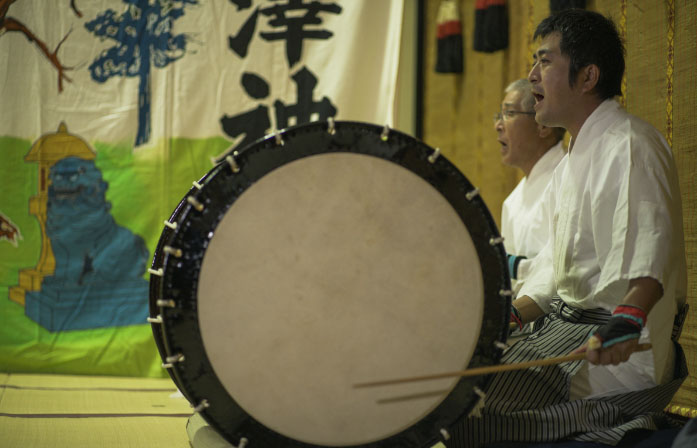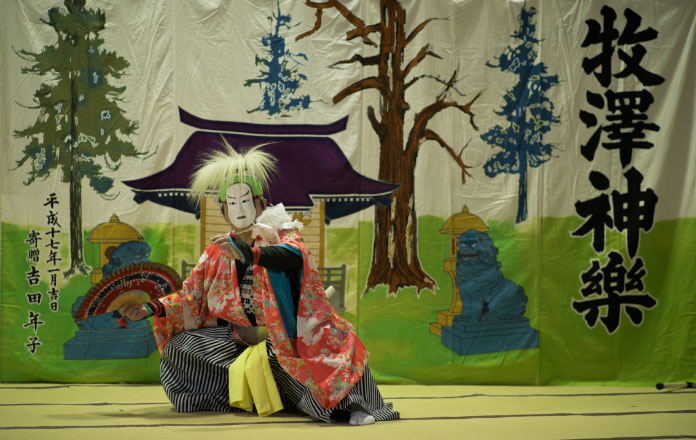NOBODY KNOWS Online Video
HIRAIZUMI
Online video
A cross talk “Tracing the life of Minamoto no Yoshitsune with performing arts
- Nambu Kagura, Nohgaku,
Nihonbuyo”
at Hiraizumi, Iwate Pref.
A cross talk show held at Chusonji Temple, designated as both Japan Heritage Site and World Heritage Site, in
Hiraizumi, Iwate prefecture. The theme is “Minamoto no Yoshitsune”, one of the greatest and the most popular
samurai warriors of Kamakura era (1185 to 1333) and of Japan history. Yoshitsune, with a lot of ups and downs,
has not only been performed in "Azumakudari (Descending East of Japan, Hiraizumi from Kyoto)" at the "Spring
Fujiwara Festival"* held every year in Hiraizumi Town during Golden Week (early May), but also in Noh, Kabuki,
and Nihonbuyo (Japanese classical dance).
He also is an essential theme in Nambu Kagura, a type of musical theatre that is still widely performed in the
region. Talking about Yoshitsune through several performing arts, the video unravels the life of Yoshitsune
and his representation in traditional performing arts such as Noh, Kabuki and Nihonbuyo, as well as in the
Nambu Kagura.
*“Spring Fujiwara Festival” in both 2020 and 2021 was cancelled to prevent the spread of
Covid-19.
- Date
- 1st October(Fri)2021 to Streaming Now! *English subtitles will be added in December 2021
- Fee
- Free
- Channel
- https://www.youtube.com/c/NOBODYKNOWS-tours
- Talk Guest
-
Yoshida Seiki, Abe Hiroki(Nambu Kagura)
Sasaki Tamon(Noh)
Hanayagi Genkuro(Nihonbuyo) - MC
- Asano Sho(Tsugaru Shamisen)
- Questionnaire
-
1st October to 13th February 2022
-Click here for the questionnaireー
From those who watched the video and answered the questionnaire, twenty people will be drawn at random to win prizes of brochures of Japan Heritage site in Hiraizumi. (Residents of Japan Only) *The information you provide may be used for all media related to public relations activities such as official pamphlets, reports, and press releases of "Japan Cultural Expo" and “NOBODY KNOWS”project.
The golden history of Hiraizumi and Japan's eternal hero, Yoshitsune
Hiraizumi once thrived on gold and its glittering history of gold production is officially recognized as Japanese
Heritage.
In Hiraizumi, the temple of Chusonji was built as an offering to those who died in the war which had been
raging in the Tohoku region until the end of the 11th century. This meant that all the victims, whether
allies or enemies, could go to the Pure Land where they would finally rest in peace. Gold was abundant in
the area and led to the development of the luxurious Hiraizumi culture, as seen in Chusonji's Konjikido - a
golden temple coated inside and out in gold leaf! Back then, Hiraizumi was the center of many exchanges of
people and goods within Japan and with the rest of the world.
Minamoto no Yoshitsune, who was sergeant of the Minamoto clan in the Heian period, also visited Hiraizumi twice. The story of Yoshitsune's journey from the capital of Kyōto to the Northeast of Japan is known as Azumakudari (literally, 'Descending East'). It has been passed down to the present day in a variety of forms and is present in traditional performing arts such as Noh and Kabuki. The story is also featured locally in Hiraizumi, during the annual Fujiwara Spring Festival as well as the Procession of Yoshitsune's Azumakudari and in the repertoire of Nambu Kagura, a musical theatre local to Hiraizumi, where Yoshitsune spent his last days. Yoshitsune appears as an eternal hero for the people of Japan but why has he been so loved by everyone?
The Azumakudari Procession celebrating the journeys of Yoshitsune to the Northeast of Japan
In Hiraizumi, Iwate Prefecture, the Fujiwara Festival is held every spring and autumn at the World Heritage sites of Chusonji and Motsuji in honour of the Oshu Fujiwara clan who led the region to prosperity. A procession of more than 100 people dressed in historical costumes, including the character of Yoshitsune, takes place on the 3rd of May. The role of Yoshitsune is played by some the most popular actors and celebrities in Japan. Many people come every year to see him on his white horse.
Yoshitsune visited Hiraizumi twice, and his journeys from the capital of Kyōto to the Northeast of Japan are
called Azumakudari (literally, 'Descending East'). First, at the age of 16, he travelled with Kaneuri
Kichiji the Gold Seller to meet Fujiwara no Hidehira, a journey which took them from Kurama in Kyōto to the
temple of Ritsugenji in Miyagi Prefecture, via Izu and the Kanto. It is said that as many as 200 monk
soldiers from Hiraizumi welcomed them upon their arrival in Ritsugenji temple. Six years later, Yoshitsune
returned to Hiraizumi while fleeing from his brother Yoritomo. That time he disguised himself as a mountain
priest and came via the Hokuriku route.
The Azumakudari Procession is a re-enactment of Yoshitsune's legendary journeys to the Northeast. Each year,
Hidehira's welcoming party departs from the foot of Chusonji and arrives in the temple of Motsuji, where the
scene of Yoshitsune's meeting with Hidehira is re-enacted at the pond of Oizumi, in the refined atmosphere
of a Japanese picture scroll from the Heian period. The procession then travels from Motsuji temple to the
golden temple of Chūsonji Konjikidō for worship.
The emblematic figure of Yoshitsune in Nambu Kagura, a musical theatre from the Northeastern region of Japan
Nambu Kagura is a type of musical theatre from the Northeastern region of Japan, from the south of Iwate
Prefecture to the north of Miyagi Prefecture, including Hiraizumi. As well as wishing for good harvests and
good fortune, the performances are also highly entertaining, with theatrical adaptations of local legends
and stories.
During the farmers' off season, Kagura festivals are held here and there, with the dancers themselves
singing their lines and drummers demonstrating acrobatic taiko techniques with highly artistic costumes and
masks. Kagura is an art form that is still alive and widely loved by the people. It is currently practised
by over 120 groups.
Particularly popular are the plays called Hoganmono, telling the story of Minamoto no Yoshitsune and Benkei,
who travelled to Hiraizumi twice and met their end there. A number of episodes tracing Yoshitsune's journey
to Hiraizumi are performed in Kagura. Encounters, hardships, wanderings, glories, falls, friendships and
romances unfold across the country, including Gojonohashi and Azumakudari, the meeting with Fujiwara no
Hidehira, the battle of Yashima and the passage of Ataka no Seki.
In this video, the Nambu Kagura group called Magisawa Kagura (Ichinoseki City, Iwate Prefecture) will
perform Gojonohashi Senningiri and Azumakudari. Gojonohashi Senningiri is about the fight between the agile
Yoshitsune and the strong Benkei. The performance is breathtaking as Yoshitsune dodges Benkei's long sword.
In Azumakudari, one can see the scene of Yoshitsune's meeting with Fujiwara no Hidehira the first time he
travelled to Hiraizumi, when he was young and still known as Ushiwaka. Yoshitsune tells Hidehira the story
of his life as the nimble Ushiwaka.
In Nambu Kagura, Yoshitsune is a popular star figure who dances with a white "zai" (hair) and a "wakado"
(young man) mask. Each Kagura group is said to have its own image of Yoshitsune, with its own unique style
of dancing, costumes and vocalizations.
FOLK PERFORMANCE
Magisawa Kagura
Has been handed down to Mashiba District in Ichinoseki, Iwate Prefecture. Inherits some characteristic
programs from Nambu Kagura, sacred Shinto dance, and is performed at the local events or festivals. They
started teaching Tori-mai, a special dance for prayer, at Mataki Junior High School in 1963, and then taught
at the Children Association of Magisawa District. They also have instructed Takizawa Elementary School since
2002. Mataki Junior High School was combined into Ichinoseki East Junior High School in 2008, but their
instruction still has been continuing. They focus on regular practices and successor trainings. Overseas
performance in Bhutan and the exchange performances are played actively.
PERFORMERS
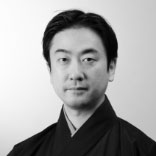
Sasaki Tamon(Noh)
Became a Noh actor of the Kita school from his father’s generations. His father was from Sakura Moto-bo, Enjoin Temple, where actors performed for the stage of Chusonji Temple. In addition to his activity at Kita Noh Theater in Tokyo, Tamon focuses on promotion of Noh in Tohoku area, such as Chusonji Takigi Noh, Sendai Aoba Noh, and Hekisuien Noh in Shiraishi City, and performs both in Japan and overseas. He enlightens children in school, has lectures to promote Noh in various places. He has performed some large-scale songs such as “Shojoran”, “Dojoji”, and “Okina” at Chusonji Hakusan Shrine Noh Theater, which has long connections with him.
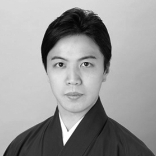
Hanayagi Genkuro(Nihonbuyo)
Born in Nara. Graduated from Tokyo University of the Arts in 2003. Is known for his colorful and powerful performance style which fascinates people, and is active in many public performances based on traditional dance. Won the Incentive Award of the Minister of Education, Culture, Sports, Science and Technology in 2017. Received the new face award from Association of Dance Critics in 2013. Has participated in Hieizan Takigi Kabuki, Ninagawa Yukio’s work, and Takarazuka Live as an assistant choreographer. In “NOBODY KNOWS” he composes and directs the stages using the story of Japan Heritage Site.
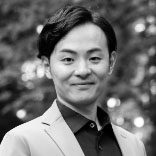
Asano Sho(Tsugaru Shamisen)
Born in Miyagi prefecture, 1990. Graduated from Keio University. At the age of 14, he was the youngest to
win the highest rank A level of the All-Japan Tsugaru Shamisen Contest and won for three consecutive years
up to 2006, recognized in its Hall of Fame. With his astounding performance skills and natural charm, he
conveys the fascination of Shamisen music. He collaborates with “MIKAGE PROJECT” which composes and
arranges folk song and classic music by oral tradition from various parts of Japan in contemporary style,
also with “ART Kabuki-dan,” a band which consists of Japanese traditional musicians. He opens up the new
music scene.
http://sho-asano.com/



